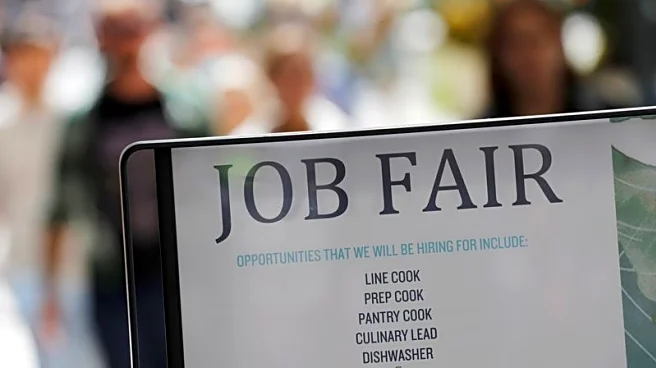What's Happening?
The U.S. hiring rate fell to 3.2% in August, marking an 'anemic level' last seen in June 2024, according to Navy Federal chief economist Heather Long. This decline in hiring comes as job openings remained steady at 7.227 million, slightly above the expected 7.185 million, yet still close to a four-year low. Job openings have been on a downward trend since March 2022. The labor market's stagnation is impacting consumer confidence, with only 26.9% of respondents in a September survey by The Conference Board (TCB) stating that jobs were 'plentiful,' a decrease from 30.9% in August. Additionally, only 16.1% of consumers expect more jobs to be available, down from 17.9%. The TCB's Consumer Confidence Index also fell by 3.6 points to 94.2, marking the largest monthly drop in a year.
Why It's Important?
The decline in the U.S. hiring rate and the stagnation in job openings are significant as they reflect broader economic challenges. A sluggish labor market can lead to decreased consumer spending, which is a critical driver of economic growth. The drop in consumer confidence suggests that individuals may be less likely to make significant purchases, potentially slowing down economic recovery. Businesses may also face challenges in finding qualified workers, impacting productivity and growth. The situation could influence policymakers to consider measures to stimulate job creation and boost consumer confidence.
What's Next?
If the trend of declining job openings and hiring rates continues, it may prompt government intervention to stimulate the labor market. Policymakers might consider fiscal measures or incentives to encourage businesses to hire more workers. Additionally, the Federal Reserve could adjust monetary policy to support economic growth. Businesses and consumers will likely be closely monitoring these developments, as any changes could impact hiring practices and spending behaviors.
Beyond the Headlines
The current labor market situation may have deeper implications for income inequality and social mobility. As job opportunities become scarce, individuals in lower-income brackets may find it increasingly difficult to improve their economic standing. This could lead to increased calls for policy changes aimed at addressing systemic issues within the labor market, such as wage stagnation and job accessibility.











